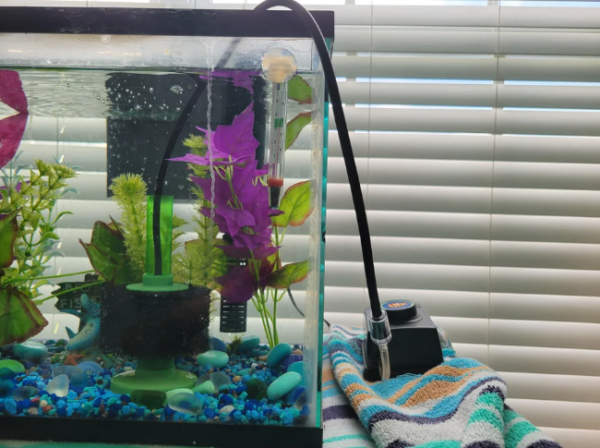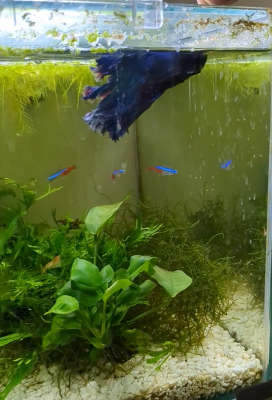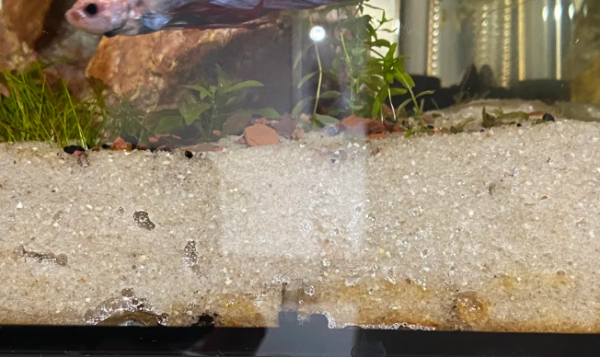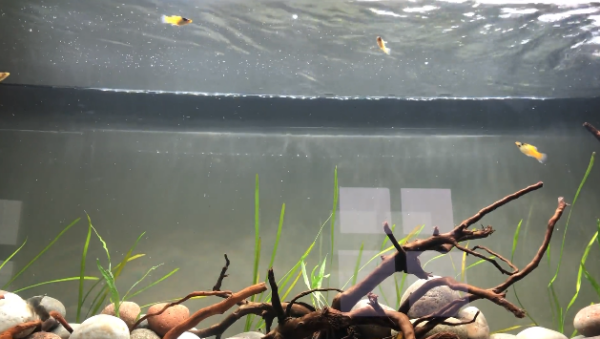Foaming or bubbling is a common occurrence in both freshwater and saltwater tanks. Various reasons, including a few trivial ones, contribute to the bubbling situation in fish tanks. While some of the reasons behind foaming are detrimental to your fish and aquatic creatures’ well-being, most reasons are misunderstood and mishandled.
Our objective with this article is to guide you, a beginner or intermediate aquarist, about all the reasons your new aquarium may bubble and create foam and inform you about the mitigation methods for the detrimental ones.
Table of Contents
12 Reasons Why Your Aquarium Water Foaming Bubbles
1. Air Pump and Airstone
Water-dissolved oxygen is a necessary element for aquatic creatures to survive in your aquarium. Well-stocked aquariums, meaning tanks with a lot of fish, require more oxygen to be dissolved in the water for all of the members to breathe and live. Moreover, some fish species require better-oxygenated water than others.
Air pumps are employed for this exact reason. They push air through a pumping mechanism that creates bubbles in the tank that pop and release oxygen into the water. Air pumps are often paired with airstones and other releasing mechanisms that create bubbles of many sizes and release them in different styles.
These airstones can create and accumulate lots of bubbles on the surface of the water. If you recently have got your tank, it’s not unheard of to have confusion about them. However, they’re completely harmless and are necessary for the well-being of the aquarium and its inhabitants.
While you may minimize their presence by reducing the air pressure or using a smaller air pump, these bubbles aren’t harmful and often make a great source of entertainment for the slow-moving fish species.
2. Temperature Changes and Gas Release
Temperature changes happen in aquariums quite frequently. Multiple factors, such as atmospheric temperature, evaporation, water changes, and surface agitation, can cause it to drop or rise significantly. In addition to causing negative effects on your fish’s health, temperature changes can cause foaming or bubbling in aquariums.
When the water temperature rises, it loses its capacity to dissolve oxygen and other gasses—reducing the dissolved oxygen percentage in water. Apart from that, these released gasses create smaller bubbles that accumulate on the surface and all over the glass, substrate, and decorations. However, these bubbles disappear within a few hours.
While the bubbles themselves aren’t a cause of concern, their creation in this case should raise alarms. The water temperature rise, if not intended, may cause discomfort to the tank’s inhabitants and reduce oxygen levels in the water. Consider taking adequate measures to reduce the water temperature to a healthy level.
A few techniques that help reduce water temperature are:
- Water changes. In hot, humid conditions, frequent water changes can reduce the temperature in the tank. However, it also can cause issues if the temperature drops suddenly. Introduce the cold water slowly.
- Increasing evaporation. Using fans over the surface increases evaporation and reduces the temperature.
- Reduce Exposure. Keep your tank indoors to reduce exposure to sun and hot weather. You may also use cooling pads on the aquarium lid to further influence the temperature.
3. Medication and Chemicals Dissolved in Water
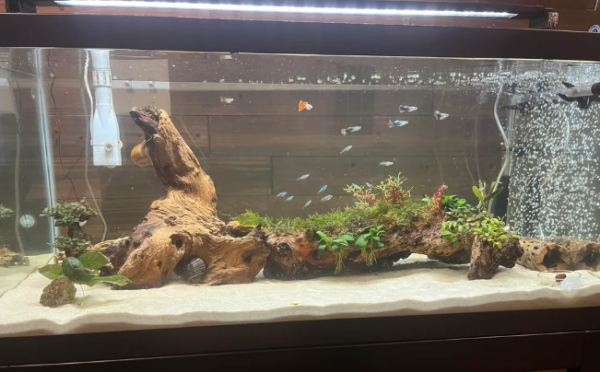
Most beginner aquarists overlook the importance of using treated DI/RO water in their aquariums. Dechlorinating tap water often fails to remove the contaminating chemicals found in it. In addition to ammonia and nitrite, which we’ll discuss later, numerous other chemicals and heavy metals can cause foaming bubbles on the surface.
Among them, high phosphate content, surfactants from soap residue, and humic substances are the major concerns. Humic substances include humic acid, fulvic acid, and humin, which are excellent natural substances to provide plants with nutrients, vitamins, and trace elements. These chemicals, when agitated and mixed with air, can cause foaming.
On the other hand, fish medications also cause foaming bubbles in the water. Antibacterial, antifungal, and antiparasitic treatments often contain surfactants to break down the biofilm or membrane protecting the microorganisms. The dissolved surfactants, when agitated, can create foam in the tank.
Water changes, increasing the number of plants, and properly treating the water before introducing it to the tank are essential precautions against chemical-related foaming. Apart from that, avoid cleaning the tank with soap and using too much fertilizer in the tank.
4. Excess Ammonia
Ammonia is a harmful chemical existing in the aquatic environment, produced by the uneaten food and fish poop. The buildup of ammonia can cause stress, internal organ damage, and death to your fish. Un-ionized ammonia (NH3) is particularly toxic to fish and needs to be eliminated as quickly as possible from the aquatic environment.
The excess presence of ammonia triggers a process that releases smaller protein fragments into the water. These fragments accumulate on the water’s surface and act as surfactants to lower the surface tension of the water. Creating more bubbles and foam in the process. It usually forms around the edges of water.
Beneficial bacteria, such as Nitrosomonas and Nitrobacter, live in the filter media and substrate to transform the ammonia into less harmful nitrite and nitrate. Which, in addition to reducing the foaming bubbles, creates a healthy environment for your aquarium inhabitants.
Growing these bacteria colonies requires patience and proper knowledge of cycling and seasoning your aquarium. Once you’ve created an optimum ecosystem for your fish and plants, you can also reduce the frequency of water changes and vacuum draining.
5. Protein Foam and Organic Waste
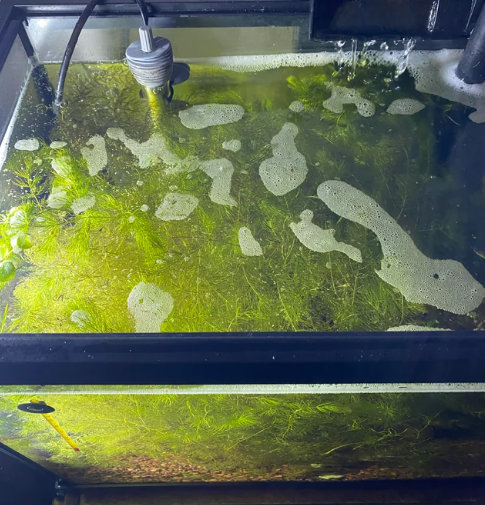
Dead plants, feces, dead fish, and uneaten food are massive sources of protein in aquatic environments. As saltwater fish have a higher bioload than freshwater aquariums and coral reefs also contribute to the massiveness of protein source, the organic load is higher in reef tanks than freshwater tanks.
The proteins in the tank, from the food waste and organic debris, are broken down by ammonia into amino acids and peptides, which accumulate on the surface of the water to cause a thin film. The thin film traps bubbles and subsequently becomes foamy. It often reduces oxygen levels in the tank and harbors harmful bacteria.
The presence of protein foam is a good indication that your tank needs a deep cleaning. Ensure that no dead fish or leaves are present in the tank and remove any debris using a substrate vacuum drainer. Moreover, regular filter maintenance and trimming of your plants will reduce protein foaming to a great extent.
You may also incorporate protein skimmers in saltwater tanks to remove the excess protein from the water surface. For freshwater aquariums, water changes are the only alternative to prevent protein foaming.
6. Oil Film on Water Surface
In addition to the protein and ammonia foam, oils from your hands, oils from fish food, and other organic compounds mix up in the water. Oils in your skin are typically hydrophobic and repel water. Therefore, it spreads out and forms a thin layer of oil.
This gooey, translucent biofilm makes bubbles pop slower and causes foaming in the aquarium. It often hinders gas exchange and reduces oxygen levels in the tank. The oil film also makes the water look cloudy or iridescent—preventing sunlight from reaching the tank and hindering the growth of the plants.
The oil film can be removed by agitating the water surface by adjusting the filter output or bloating the oil with tissue paper. However, it’s not a common issue and may not require taking any action on your part unless you see light foaming on the edges of the tank.
7. Typical Fish Behavior
Many freshwater and even some saltwater fish species make bubble nests on the surface of the water for their females to lay eggs and fry to hatch. Typically the males of the species breathe air from the surface and carefully place the bubbles on the water surface to make the nest. Betta Fish, Gouramis, and Paradise Fish are typical examples of freshwater fish that make these bubble nests.
This is typical fish behavior and can be observed even without the presence of both sexes. Although the presence of a female may agitate the male to build it faster. If you’re seeing small bubbles accumulating on the surface and your Betta is being too active, it may be because it’s building a bubble nest.
Bubble nests are temporary and don’t cause any harm to plants or other community fish. However, if you wish to breed your Betta or similar fish, it’s better to provide them with an environment with low to zero water currents and lots of hiding spots.
8. Plant and Algae Photosynthesis
Healthy plants existing in your tank absorb light in the daytime for photosynthesis, a process that generates energy for the plant to grow and releases oxygen during the process. If your tank oxygen levels are saturated, the excess oxygen forms tiny bubbles and occasionally reaches the surface. A similar process can be observed on the glass and decorations if your tank has a blooming algae population.
Experts call this phenomenon pearling and is considered a sign of a healthy aquarium ecosystem. These bubbles, expectedly, don’t harm the fish or other aquatic creatures.
However, a few factors that influence pearling are:
- Light intensity. Sufficient light intensity is necessary for photosynthesis. Pearling may not even be noticeable if your aquarium doesn’t have adequate lighting or access to ample sunlight.
- CO2 levels. Elevated CO2 levels are critical for photosynthesis. Lack of the same may reduce pearling in your aquarium. Many planted tank owners inject CO2 into the tank for better plant health.
- Plant species. Different plant species have different photosynthesis rates. Therefore, pearling may vary between plant species.
- Water circulation. Consistent water circulation ensures that the bubbles don’t accumulate on the leaves for photosynthesis and pearling is continued.
9. Gas Pockets in Substrates
In well-seasoned tanks with fine substrates like sand or mud, gas pockets often form under the aquarium bed and may climb to the surface if they grow larger or are agitated. In most cases, these pockets are caused by toxin gasses and may harm the plants and fish.
The anaerobic decomposition of organic matter is the primary reason for these pockets to develop. When organic matter, such as uneaten food or dead plants, decomposes in an environment with low oxygen levels (such as in the substrate), methane, hydrogen sulfide, and other harmful gasses are generated. These gasses form pockets in the substrate where there is low water circulation.
Denitrifying bacteria convert nitrate into nitrogen gas in anoxic zones (oxygen-depleted) of the substrate. As nitrogen gas is produced, gas pockets are formed in the substrate.
Some fertilizers used in aquariums may contain gasses, such as ammonia, which may form pockets in the substrate if not dissolved and nitrified by the beneficial bacteria.
A few tips that may help you with gas pockets are:
- Agitate the substrate. Occasionally stir up the substrate of your seasoned aquarium and try to improve water circulation by eliminating compaction.
- Do partial water changes. Water changes remove excess organic matter and may reduce gas levels in the water.
- Grow beneficial bacteria. Having adequate beneficial bacteria will reduce the formation of gas pockets in the tank. However, you must also ensure proper water circulation.
- Reduce the amount of fertilizers. Focus on creating a self-sustaining ecosystem through a symbiotic relationship between the plants and the fish.
- Control algae growth. Reduce lighting, don’t overfeed your fish, and add more plants to control algae growth and the formation of gas pockets.
10. Filtration Systems, Protein Skimmers, and CO2 Regulators
Various equipment, including filtration systems, protein skimmers, and CO2 regulators, form bubbles at some stage during their operation. While the filtration systems can be regulated to not form bubbles, protein skimmers and CO2 regulators rely on bubbles to essentially function.
These bubbles aren’t mostly harmful to your fish. However, CO2 regulators should be adjusted according to the tank requirement to prevent carbon dioxide from replacing the dissolved oxygen.
11. Leakage in Equipment
As mentioned, multiple equipment in aquariums rely on air pressure to work. Leakage in these pieces of equipment may also cause foaming bubbles in your tank. It should be a cause of concern and can damage the equipment or harm your fish. Do consider fixing or replacing them as soon as possible.
12. Micro Bubbles Due to Water Change
During colder months, you may see micro bubbles covering the glass, plants, and decorations after water change. This happens mostly if you use colder tap water for your tropical aquarium with heaters. The higher percentage of dissolved oxygen in colder water gets heated in the aquarium and releases the excess oxygen in the water to form tiny bubbles.
The bubbles should disappear in a few hours, but if a huge amount of bubbles were formed, it could mean that a wide temperature deviation has occurred in the tank. Temperature changes can affect water parameters, such as pH and dissolved oxygen, and cause discomfort to inhabitants.
Keep a close watch on your tank for a few hours or days to ensure there aren’t any anomalies in the behavior of your fish.
FAQs
Some types of bubbles are OK to have in the fish tank, while some of them may indicate complex issues. Bubbles formed through airstones, filters, and normal fish behavior are nothing to be worried about, but air pockets in substrates and protein foams shouldn’t be neglected.
In most cases, agitating the surface and water changes eliminate the bubbles in the tank. But, gooey, translucent foamy bubbles may need to be removed by employing better filtration or skimming systems.
You labyrinth fish, those who can breathe from the surface, like Betta Fish and Gouramis, make bubble nests for their offspring. If you’re seeing them making and accumulating tiny bubbles on the surface, they may be creating bubble nests.
The Bottom Line
We’ve discussed most of the reasons why your aquarium water is foaming bubbles, and hopefully, you’ll now understand the reasons for bubbles forming and be able to mitigate them.

